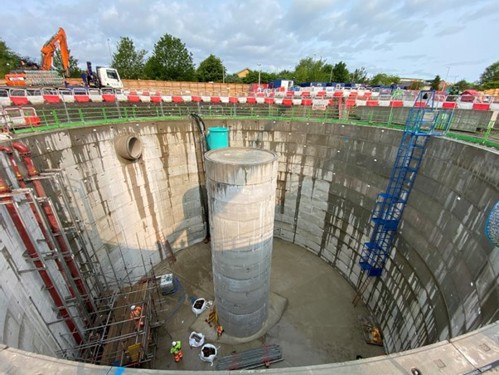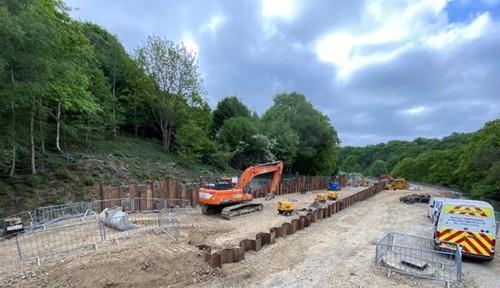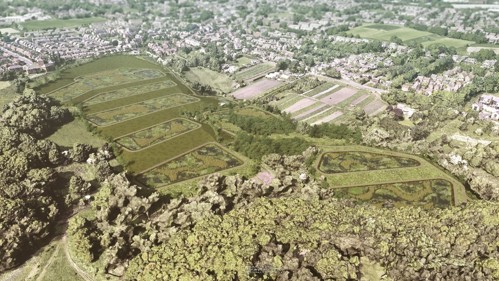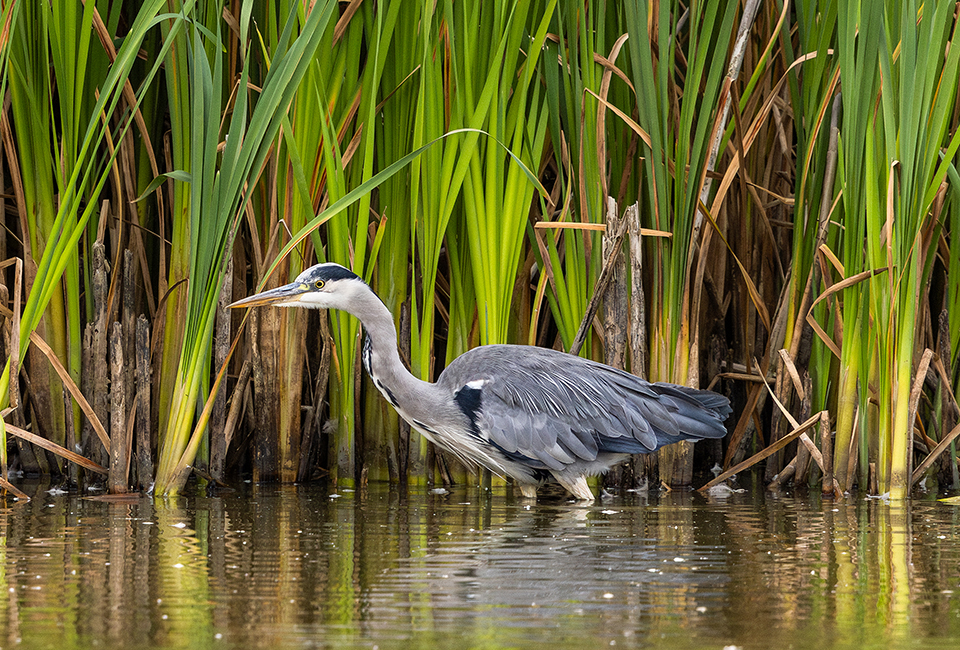Dick Lane
We’ve been installing a new storm water storage tank with a capacity of 3,000 cubic metres. This upgrade will help reduce storm overflow discharges into Pudsey Beck by approximately 65%, especially during periods of heavy rainfall. The works have been carried out by our contractor, Peter Duffy Limited. As we near scheme completion in December 2025, we would like to once again thank you for your understanding as we’ve been carrying out these works.

Pudsey Smalewell
We’ve been constructing an even larger storm water storage facility, which is 3,500 cubic metres in capacity. This will reduce storm overflow discharges by around 77%.
Due to a request by the regulator, we’ve been informed that we now need to add more additional storage to this site. We’re investing a further £10m to achieve these aims, which will add further resilience to our wastewater network and contribute to higher water quality in Pudsey Beck.
Our contractor Tilbury Douglas is leading the works at this site, which are expected to last 24 months. The public right of way on Tyersal Lane will continue to remain open during construction.

Farnley Ring Road
We’re submitting a planning application to Leeds City Council to add additional 5000 cubic metres of storage to our system, which will improve the performance of our local storm overflows. This work could potentially have temporary impacts to vehicle access and journeys, and we’re engaging with residents affected. We’re planning to start this work in Summer 2026, but we will continue to keep the community updated on progress.
Pudsey Hough Side Wetland
The Pudsey Hough Side Wetland will be a 4.2-hectare nature-based solution designed to treat storm water and improve the quality of water in Pudsey Beck. We’re working with our project delivery partner Kier to carry out the work.
It will consist of interconnected wetland cells (ponds) planted with native vegetation that naturally filters water and supports biodiversity. One of the wetland cells will be open to the public, allowing residents to observe its ecological benefits.
A public right of way currently runs through the site and will be temporarily diverted during construction. Once the wetland is complete, the path will be rerouted along the side of the wetland to maintain access. Planning permission is currently in progress, and Yorkshire Water is working closely with delivery partners and local stakeholders to minimise disruption during construction.

Pudsey Hough Side FAQs
What is the Pudsey Hough Side Wetland project?
The Pudsey Hough Side Wetland is a proposed 4.2-hectare nature-based solution designed to treat storm water and improve the quality of water in Pudsey Beck. It will consist of interconnected wetland cells (ponds) planted with native vegetation to naturally filter water and support biodiversity.
Why is this project being developed?
This wetland is part of Yorkshire Water’s £8.3 billion environmental investment programme over the next five years. At least £83 million of this is dedicated to nature-based solutions like wetlands, which help protect watercourses and enhance local green spaces.
For this particular project, we are using the wetland to treat stormwater, which is a mix of excess surface water and some diluted and untreated domestic wastewater.
What are the environmental benefits?
- Improved water quality in Pudsey Beck
- Natural storm water treatment
- Enhanced biodiversity and wildlife habitat
- Creation of a public green space for community enjoyment
Will the public have access to the wetland?
Yes. One of the wetland cells (ponds) is planned to be open to the public. A public right of way currently runs through the site and will be temporarily diverted during construction. Once complete, the path will be rerouted along the side of the wetland to maintain access.
What is the current status of the project?
Planning permission is still in progress. Updates will be shared with the community as the project moves forward.
Do people support the construction of the Pudsey Hough Side Wetland?
We held two drop-in events on 26 September and 10 October 2025.
The local community were largely supportive, and we’ve displayed our written feedback received below:
| Sentiment | Feedback count | Feedback % |
|---|---|---|
| Very positive | 12 | 48% |
| Positive | 8 | 32% |
| Neutral | 4 | 16% |
| Negative | 1 | 4% |
| Very negative | 0 | 0% |
What are the construction hours and how will disruption be managed?
Normal working hours: Weekdays, 07:30 to 17:30
Occasional extended hours may occur, with advance notice
Yorkshire Water is working with partners and stakeholders to minimise disruption
Who can I contact for more information?
Please contact the Customer Experience team at 0344 848 1099, quoting the reference number at the top of your letter.
Does the wetland have local political support?
Yes, we know local councillors support the scheme in principle. We have provided robust reassurances that there will not be any odour issues for local people.
What types of plants will be used in the wetland?
The wetland will be planted with a variety of native wetland species that are well-suited to filtering water and supporting local biodiversity. These may include reeds, rushes, sedges, and flowering aquatic plants. A full planting list will be available at the drop-in events.
Will there be mosquitoes or other pests?
Healthy wetlands support a balanced ecosystem, including natural predators like dragonflies and birds that help control mosquito populations. There will be a flow of water, which will minimise stagnant water, preventing mosquitoes from laying their eggs and breeding.
How long will construction take?
The exact timeline will depend on planning approval and weather conditions, but updates will be provided regularly. Construction will follow standard weekday hours (07:30–17:30), with occasional extended hours if needed.
Will the wetland be safe for children and pets?
Yes, safety is a priority. The public-access areas will be designed with safe pathways and signage, and the wetland cells (ponds) will be separated from walkways. However, supervision is always recommended near water.
How will the wetland be maintained?
Yorkshire Water and its partners will be responsible for ongoing maintenance, including vegetation management, litter removal, and monitoring water quality to ensure the wetland continues to function effectively.
Our wetlands are designed to not need full replanting for up to 20 years.
Can schools or community groups get involved?
Absolutely! The project team welcomes community engagement and will explore opportunities for local schools and groups to participate in educational visits, planting days, or citizen science activities.
More from us
Storm overflows
Find out what stormover flows are, why we have them and how they work.


Storm overflow investment
To help us drive improvements in our storm overflows quicker, we’re investing in some of our most active storm overflows to reduce the number of times they operate.
Investing in Yorkshire
From fixing leaks to making new wetlands. From helping customers struggling with bills, to giving back by helping communities thrive.


